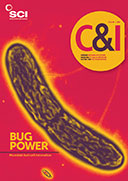Protein misfolding is the key step in the development of a host of neurodegenerative pathologies from Alzheimer’s to Parkinson’s. Now, scientists have hit on a quite unexpected discovery - that a small molecule drug can stop this disease process from occurring and prevent misfolding of a much bigger protein structure.
The researchers at Massachusetts-based Alzheon made the discovery during investigations of a small molecule called tramiprosate (3-aminopropanesulfonic acid), which prevents the misfolding of amyloid monomer protein to form neurotoxic beta amyloid oligomers – believed to be one of the main triggers for Alzheimer’s disease, explains Martin Tolar, Alzheon CEO.
‘Naturally, amyloid protein acts to repair injury in the brain,’ says Tolar. ‘If you are hit on the head, concentrations of amyloid go up. We knew in the past that amyloid is essential in pathogenesis of Alzheimer’s disease, but we didn’t previously know what form of amyloid was toxic. Now there are hundreds of papers showing it’s the formation of these toxic oligomers that’s the problem.’
Alzheon’s discovery relates to the detailed molecular mechanism how tramiprosate works, he continues. ‘To our surprise, we found it doesn’t interact one on one like many other drug and receptor interactions. Instead multiple drug molecules form a cloud or “envelope” around the native amyloid structure. The importance of this is that a small molecule can modulate the shape of a large molecule and prevent misfolding.’
The finding ‘opens the door to the development of a new class of drugs with disease-modifying potential for Alzheimer’s, as well as other neurodegenerative disorders caused by protein misfolding,’ according to Nobel laureate Stanley Prusiner, chair of Alzheon’s scientific advisory board. It suggests the same ‘enveloping’ mode of action could be applied to develop small molecule modulators against a range of other neurodegenerative conditions, including against prions involved in Creutzfeldt-Jakob disease as well as tau, another protein implicated in Alzheimer’s disease.
The study, published in CNS Drugs (https://link.springer.com/article/10.1007/s40263-017-0434-z), employed Ion Mobility Mass Spectrometry (IMS-MS), NMR and molecular dynamics to characterise the interactions of tramiprosate with AB42 amyloid monomers. It also determined the optimum amount of tramiprosate needed for full ‘inhibition’ of amyloid folding - around 1000 tramiprosate molecules for every amyloid peptide.
‘Tramiprosate is a very special molecule to do this enveloping,’ Tolar says. ‘It has to be small to get into the brain; in fact, tramiprosate achieves about 40% brain penetration.’ The compound interacts with amyloid non-covalently, he points out, by jumping on and off the peptide at multiple different binding sites along its length.
Tramiprosate was originally developed by a Canadian company called Neurochem, but failed a Phase 3 drug trial for Alzheimer’s back in 2009. Alzheon later acquired the rights to the compound and tweaked it to make the optimised prodrug ALZ-801, ready to start Phase 3 trials for a specific subset of Alzheimer’s patients with a APOE4/4 genotype.
Previous analyses have shown that tramiprosate significantly improves cognition and function in Alzheimer’s patients with two E4 alleles of apolipoprotein E (APOE4/4 homozygotes), Tolar notes.
‘The key problem in Alzheimer’s drug development is misdiagnosis. Almost 30% of subjects enrolled in studies based on clinical symptoms do not have Alzheimer’s. Focus on APOE4 homozygotes brings down the misdiagnosis to less than 5%.’
Although the biggest risk factor for AD is age, he points out that a fifth of the global population carries APOE4/4 which puts them at a greater risk for the disease. The company plans to begin a Phase 3 clinical trial of ALZ-801 in ‘less than 500’ AD patients who are APOE4/4 homozygotes later in 2017, to be followed by studies in all patients with Alzheimer’s.
As a recent article in C&I (2017, 1, 26) points out, meanwhile, other experimental antibody treatments targeted against amyloid peptide have delivered mixed results. Phase 1 trials of the antibody treatment aducanumab – developed by another Massachusetts-based company Biogen – revealed it significantly reduced levels of toxic amyloid beta plaques in the brain and slowed cognitive decline in patients. But both Merck’s verubecestat and Eli Lilly’s solanezumab recently failed Phase 3 trials.
‘Our advantage is safety data,’ Tolar says, pointing out that the problem with antibodies is that very little drug reaches the brain. ‘ALZ-801 is an oral drug. Two thousand patients given tramiprosate showed only a small amount of vomiting and nausea, which was improved with the new ALZ-801 formulation.’
Tolar is particularly enthused about the potential for ALZ-801 to stop progression of Alzheimer’s disease at an early stage, before symptoms become more serious. New imaging technologies make it possible to diagnose AD much earlier, when ‘bad amyloid’ starts to form, but no symptoms are yet evident. A study of 65-year-olds in the US found 28% had AD brain pathology but no symptoms, he notes – equivalent to 16m people if extrapolated to the US population at large.
While most currently available treatments for neurodegenerative diseases treat only the symptoms of disease, he says that initial testing of ALZ-801 demonstrated ‘dramatic improvements for patients, showing that it could potentially even stop this progression and prevent the onset of symptoms in patients who already have the disease’.
None of the independent experts approached by C&I was available for comment.




